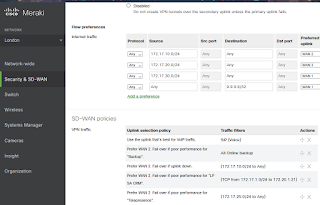Capture the Flag is a networking game that will allow you to gain hands-on experience with designing and operating cloud-based solutions with the Cisco Meraki platform.
#CiscoCTF
Find it HERE (Until July 17th 2020) - An Online treasure hunt! Where the treasure is "things to put onto your resume."
After signing up, you log into an emulator of a Meraki dashboard.
This is how it looks forreal. I've used Meraki in demos before!
One of the clues is
"What is the name of the custom performance class configured at London’s MX which matches the metrics described?"
[metrics ommitted by runtcpip.com]
Then you go to the appropriate page and you look around; When you answer successfully, you get a nice,DOS-esque screen;
There are hints; Don't be ashamed to use them, even if you lose points. It's all a learning experience!
Even if said hints are a strange mixture of vague and obvious.
Change Access Point Radio Frequency somewhere in the 'Wireless' menu? Groundbreaking.
You don't lose points from clicking 'Read More Task Details'.
When even the hints have you stumped, there was an open WebEx chat where someone was on hand to help.
Shout out to Nate Austin for helping me with #18 - You can run APIs here, you don't need to download Postman if you're a beginner! I found where to put the API key myself and got the correct answer.
You can also get an e-mail with a summary of the "flags" you've captured.
Things I learned
- Meraki has cameras!
- Meraki appliances can be configured in different deployment modes.
- When blocking with filters, site categories are updated dynamically.
Retweet?







Comments
Post a Comment